Do you speak RUNNING?
Guest blog by Customer Service Manager Eric Oliva
Running has developed its own language, and today’s blog will help make the shoe wall at the store seem a little less intimidating and more understandable.
At St. Pete Running Company, we have personally run in and researched every shoe before it makes an appearance on our shoe wall. No single brand of running/walking shoe that we carry is better than any of the others when it comes to capability and durability. Plus higher price does not necessarily mean a better shoe. What is “better” for you will be determined by things like your mechanics, the fit, and your goals rather than the price or color scheme. Within each brand, there are premium neutral and premium stability models, standard neutral and standard stability models, and responsive lightweight models.
3 Ways To Break Down the Shoe Wall:
- Premium Vs Standard
- Neutral Vs Stability
- Responsive & Lightweight
PREMIUM VS STANDARD
“The more expensive one must be a better shoe…RIGHT?!?”
 Men’s Brooks Levitate: a premium model
Men’s Brooks Levitate: a premium model
The difference between a standard model and a premium model is that the premium models are outfitted with all the latest and greatest technology that the brand has released. New features like this will often debut on their premium models and then trickle down to lower priced models in the following update.
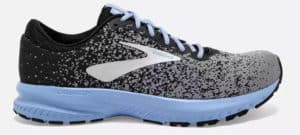 Women’s Brooks Launch: a standard model
Women’s Brooks Launch: a standard model
The catch is typically added weight penalty. If you are running a lot of miles, just getting back into running, have previous injuries, or are trying to correct some mechanics, you may benefit from these features and not care about the added weight. Others might favor a standard model in order to find the right balance of effectiveness, comfort, and weight.
NEUTRAL VS STABILITY
“I don’t need a stability shoe to get arch support?!?”
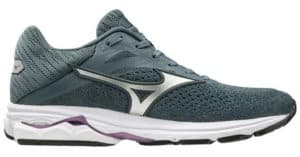 Women’s Mizuno Wave Rider: a neutral model
Women’s Mizuno Wave Rider: a neutral model
A neutral shoe will have little to no effect on your natural stride while a stability shoe prevents your foot/ankle from crashing inwards. Just because you are fitted for a stability shoe one time doesn’t mean you won’t be fitted for a neutral shoe down the line, or vice versa. Many things will affect this such as running form, body mechanics, injuries, physical traits, and sometimes even the pace you are running.
A neutral runner’s foot will tend to stay relatively flat on the running surface, and at times they may even supinate (underpronate), which is where the outer edge of the foot is favored. If a neutral runner were to run in a stability shoe, it could push the foot further to the outside edge causing pain on the outside of the foot, knee, or IT band.
Overpronation is when the ankle and foot tend to roll inwards towards the runner’s arch as they bear weight on it through their stride. Often, the outside edge of the shoe is lifted from the running surface. A stability model shoe will use a more dense foam, plastic support, or a combination of the two on the arch side of the midsole in order to prevent the inward rolling of the ankle, thus keeping the runner’s foot flat on the running surface.
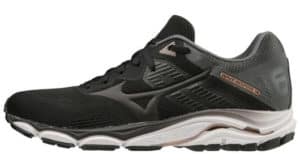 Men’s Wave Inspire: a stability model
Men’s Wave Inspire: a stability model
Neither overpronation nor underpronation refers to the orientation of the toes from the body (duck-footed or pigeon-toed), but rather to the relationship of the entire foot and ankle relative to the running surface. In addition, other features a runner may desire in a shoe such as arch support, level of cushioning, or a wide/narrow toe box can be found in both a neutral and a stability type shoe.
RESPONSIVE AND LIGHTWEIGHT
“What is heel-toe-drop and does it even matter?”
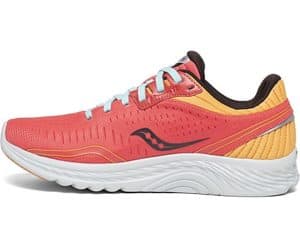 Women’s Saucony Kinvara: a lightweight, responsive model
Women’s Saucony Kinvara: a lightweight, responsive model
Some shoes are designed to be lighter weight, feel more “springy,” and facilitate a faster running pace. The level of responsiveness depends on the shoe’s response to your toe’s push off and your forward motion as you pick up the pace. When running faster, you don’t want to lose any of your effort sinking into the enjoyable cushioning of your daily trainer. Lightweight shoes react to any effort you exert, maximizing rebound and forward motion. This translates to less required effort to go faster! Lightweight shoes are great for speedwork, tempo runs, and race day.
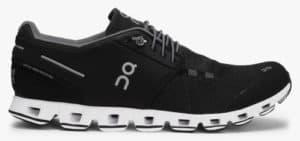 Men’s On Cloud: a lightweight, responsive model
Men’s On Cloud: a lightweight, responsive model
What makes a shoe more responsive is slightly different across brands, but in general, there is less foam or gel between your foot and the ground, a different, more firm or springy type of foam or gel is used instead, or they achieve a snappier feeling by cutting the flex grooves on the bottom shallower or utilizing a polymer insert as part of the midsole.
Heel-toe-drop is measured in millimeters and describes the difference in elevation from the ground between your heel and forefoot. In most cases, a daily trainer will range between 10-12mm and a responsive lightweight model will range between 4-6mm. A lower drop shoe will be lighter and can facilitate better running form, but a higher drop shoe will protect those who have a history of chronic calf tightness, achilles injuries, or even plantar fasciitis.
HOW DO I KNOW WHICH SHOE I NEED?
At St. Pete Running Company we use a unique process called StrideSmart to find the shoe with perfect fit for you on an individual, case-by-case basis.
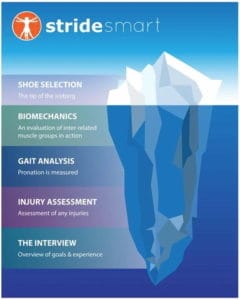 During the interview, we will key in on information you provide regarding your medical history, past running accomplishments, current training, and future goals to kickstart the fit process. You then will have the opportunity to see yourself, in slow-motion video, perform a few movements on the store floor and run/walk on a treadmill from multiple angles. Together, we will review this to offer advice on running form and to identify muscle imbalances, tightness, or pronation. The combination of our conversation and what we see on the video translates to that overwhelming shoe wall being reduced to a handful of models matched perfectly to you. The last step is trying them on, choosing the best fit, and then accomplishing your goals!
During the interview, we will key in on information you provide regarding your medical history, past running accomplishments, current training, and future goals to kickstart the fit process. You then will have the opportunity to see yourself, in slow-motion video, perform a few movements on the store floor and run/walk on a treadmill from multiple angles. Together, we will review this to offer advice on running form and to identify muscle imbalances, tightness, or pronation. The combination of our conversation and what we see on the video translates to that overwhelming shoe wall being reduced to a handful of models matched perfectly to you. The last step is trying them on, choosing the best fit, and then accomplishing your goals!








